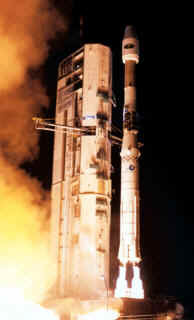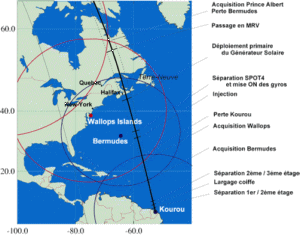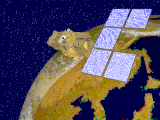
(*) countdown can be wrong with Windows 3.xx systems.
Launch and early orbit phase
The SPOT orbit
Decision team
Constraints
Operations and
timing
Additional operations
TT&C stations monitor
early orbit phase
First scenes
Final orbit acquisition
Solar array deployment
The launch phase involves a series of delicate operations not only for the Ariane 40 launcher, but also for the fully-assembled satellite under the third-stage payload fairing. The launch phase starts at T0 - 10:00 and ends 18 minutes and 25 seconds after lift-off when the satellite separates from the launcher. The satellite, controlled by its onboard computer, then begins a series of automatic operations known as the "acquisition sequence". At the end of this sequence, the payload instruments are pointing earthward and the satellite's internal configuration is very close to that required for routine operations.
During the acquisition sequence, the various computer centres and operational teams that will monitor the satellite, program imagery acquisition and process the imagery must be ready to perform their assigned duties. From the moment the Ariane launcher places the satellite in orbit, the system must be ready to operate in precisely the way intended by its design teams.
One of the biggest challenges in launching a satellite is the fast succession of critically important operations during the first few orbital revolutions. If all goes well during these first few hours, the new space system (comprising the satellite, or space segment, and the associated ground segment) will soon be operational.
 Most Ariane payloads are telecommunications
satellites that must be placed in geostationary orbit. Compared to these, SPOT 4 is
rather special. First, the launcher heads North, not East. Following lift-off from the
ELA2 launch pad at Kourou in French Guiana, the launcher flies over the eastern tip of
Newfoundland, Canada, then on to the North Pole. The target orbit
is 20 km below the nominal orbit. This will be adjusted during final orbit
acquisition.
Most Ariane payloads are telecommunications
satellites that must be placed in geostationary orbit. Compared to these, SPOT 4 is
rather special. First, the launcher heads North, not East. Following lift-off from the
ELA2 launch pad at Kourou in French Guiana, the launcher flies over the eastern tip of
Newfoundland, Canada, then on to the North Pole. The target orbit
is 20 km below the nominal orbit. This will be adjusted during final orbit
acquisition.
The final orbit, which is polar, at an altitude of 830 km, and practically circular, is identical to that used by SPOT 1 and SPOT 2.
To ensure that the decision team has access to all the necessary data throughout the launch phase, the telemetry transmitted by SPOT 4 is relayed directly to Toulouse for real-time processing by the operations control centre, or CMP. The data are then analysed by a dedicated team in the main control room, or SCP. From the time launcher and satellite separate, the SCP is the key entity coordinating all the resources involved in sending commands to the satellite via the TT&C stations mobilized for the occasion.
Project and operations team leaders, key members of the satellite design team and senior CNES executives are all on hand in the main control room, monitoring the operations closely and ready to take decisions quickly in the event of an anomaly or mishap.
The launcher's capabilities plus the fact that SPOT 4 must be placed in precisely the required orbit result in a launch window of just 9 minutes per day. During this time, launcher, satellite and a global array of ground facilities (radars, data transmission networks, optical tracking and range safety equipment, TT&C stations, computers and other facilities in Toulouse), must all be ready to do their respective jobs. When all is in order . . . and provided the weather in Kourou is clement, the indicators in the main control room remain green and the countdown proceeds normally.
The limited capacity of the satellite's onboard batteries (around 5 hours) is one of the most determining and critical factors during the launch phase. The satellite's attitude must be quickly brought under control so that the deployment of the solar array can begin and the array's solar cells can be maintained perpendicular to the Sun's rays. The electrical energy generated by the array is essential both to the satellite's survival and to the forthcoming operations.
All of these critical operations have been carefully prepared and planned. They have also been repeated in the course of many rehearsals during the pre-launch qualification phases.
Operations such as hardware and software configuration and final satellite-level functional tests are performed using so-called "Ground Support Equipment" that are on site at Kourou from the start of the launch campaign. The satellite is hooked up to a suitcase model via the launcher's umbilical connector which is jettisoned a few seconds before lift-off.
During the powered flight phase and until the satellite separates from the launcher, the operation of the satellite is monitored via the launcher telemetry. While the satellite's condition is monitored by the main control room in Toulouse, launch operations are controlled by CNES and Arianespace teams in Kourou.
Separation triggers an automatic sequence that starts up the attitude control system. The satellite's onboard propulsion system uses small hydrazine thrusters to reduce the satellite's rates of rotation about its different axes. Progressively, the system stabilizes the satellite then brings the earthward side carrying the imaging instruments around until it faces the earth, this operation being known as "earth acquisition".
Pyrotechnic commands synchronized by the flight software successively release the securing devices protecting sensitive items of equipment against launcher-induced vibration or holding certain items in the stowed position beneath the launcher fairing during the powered flight phase.
Items secured in this way include the solar array, the HRVIR strip-selection mirrors, the reaction wheels, the PASTEL telescope, and the Vegetation payload's calibration system.
These operations being critical to the satellite's survival and continuing system operations, each one is monitored particularly closely by the CMP and SCP engineers. Normally everything proceeds automatically. With the one exception of the solar array, all the other items are fully backed up. The CMP and SCP engineers must, however, be ready to respond to any anomaly and to prepare and send commands to correct the situation.
 This automatic sequence takes about 35 minutes from
separation, after which, the solar array is
deployed, begins tracking the Sun and the
satellite is correctly oriented.
This automatic sequence takes about 35 minutes from
separation, after which, the solar array is
deployed, begins tracking the Sun and the
satellite is correctly oriented.
This automatic sequence is not all there is to the early orbit phase. As soon as the automatic sequence has been completed, the project team, in cooperation with senior satellite operations staff, takes control and executes a series of operations, including:
SPOT 4 is scheduled to achieve its operational configuration about 36 hours after lift-off.
The critical operations just described are undertaken while the satellite is within range of one of the TT&C stations mobilized for the occasion so that ground operators can respond quickly in the event of a problem. Throughout the first orbital revolution, the CNES TT&C network is backed up by other stations on the launcher's trajectory in the United States, Canada and Japan. The tasks assigned to the different stations during these first periods of contact are:
The HRVIR instruments should be available to record their first, long-awaited scenes three days after launch; the Vegetation instrument after seven days. The main reason for the wait is the time required for moisture desorption by the SWIR sensors in the hard vacuum of space (i.e. water molecules in the sensor material take a while to be driven off by the vacuum).
The last phase, termed, involves adjusting SPOT 4's orbital phase relative to SPOT 1 and 2. These manœuvres can take from 1 to 18 days, depending on the launch time and date and the precise orbit in which the Ariane launcher leaves the satellite.
![]()
page updated on the 00-06-06